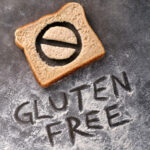
How can I still eat my favorite foods?
Eating and baking gluten–free has become much easier recently as more companies now make gluten–free products. You can now buy gluten–free breads, rolls, pasta, pizza crusts, buns, bagels, donuts, cookies, muffins, pretzels, cereals, and desserts. The following list of brands has a great selection of gluten–free foods which you can buy directly from their websites or at many grocery stores. This list is not meant to be an endorsement of these brands, is not all encompassing, and because products change over time, you should still check the ingredient labels of all products.
Here are some brands that carry gluten-free products
- Amy’s Kitchen®
- Bell and Evans®
- Boar’s Head®
- Bob’s Red Mill®
- Brazi Bites®
- Canyon Bakehouse®
- Chebe Bread®
- Crunchmaster®
- Ener–g Foods, Inc.®
- Enjoy Life Foods®
- Envirokidz®
- Feel Good Foods®
- Food For Life®
- Food Should Taste Good®
- GeeFree
- GF Harvest
- Glutino®
- Ian’s®
- Jovial Foods ®
- KIND®
- Kinnikinnick Foods®
- LaraBar®
- Lundberg Farms®
- Mary’s Gone Crackers®
- Pamela’s Products®
- Rudi’s Bakery
- San-J
- Schar
- Tinkyada
- Udi’s®
- Van’s Natural Foods
How do I shop for gluten–free foods at the grocery store?
Many grocery chains carry the gluten–free brands mentioned above. These products are commonly found in the aisles that contain natural and organic foods or they may even have their own section, labeled “gluten-free foods.” Often gluten-free bread, bagels, and prepared food is found in the freezer. It’s also important to remember that most of the fresh foods found along the perimeter of the store (outside aisles) including fruits, vegetables, meat, poultry, fish, and dairy are naturally gluten–free. Rice, beans, peanut butter, nuts, cooking oils, and corn and rice cereals are also typically gluten–free.
Watch for possible gluten cross–contamination when shopping. This means foods that have gluten in them come in contact with gluten–free foods. Be aware of gluten cross–contamination at the deli counter (shared serving utensils, meat/cheese slicer) and salad bars.
| Gluten-Free Grocery Lists: |
Dairy
|
Fruits:
|
Vegetables
|
Grains:
|
Proteins:
|
Snacks and Desserts:
|
Condiments and Seasonings:
|
Our health guides are developed through a systematic, rigorous process to ensure accuracy, reliability, and trustworthiness. Written and reviewed by experienced healthcare clinicians from Boston Children's Hospital, a Harvard Medical School teaching hospital and consistently ranked as a top hospital by Newsweek and U.S. News & World Report, these guides combine clinical expertise, specialized knowledge, and evidence-based medicine. We also incorporate research and best practices from authoritative sources such as the CDC, NIH, PubMed, top medical journals, and UpToDate.com. Clinical specialists and subject matter experts review and edit each guide, reinforcing our commitment to high-quality, factual, scientifically accurate health information for young people.

